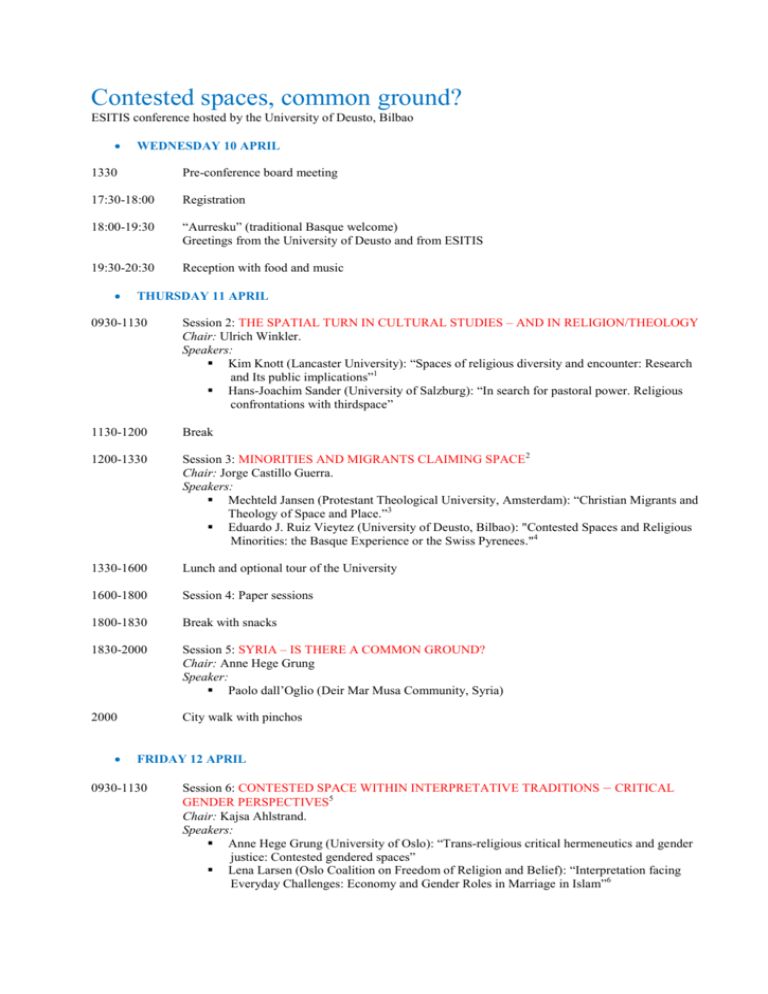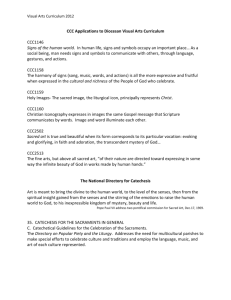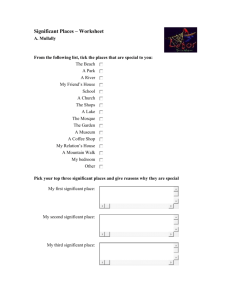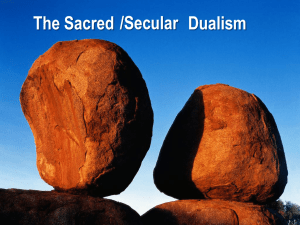Contested spaces, common ground?
advertisement

Contested spaces, common ground? ESITIS conference hosted by the University of Deusto, Bilbao WEDNESDAY 10 APRIL 1330 Pre-conference board meeting 17:30-18:00 Registration 18:00-19:30 “Aurresku” (traditional Basque welcome) Greetings from the University of Deusto and from ESITIS 19:30-20:30 Reception with food and music THURSDAY 11 APRIL 0930-1130 Session 2: THE SPATIAL TURN IN CULTURAL STUDIES – AND IN RELIGION/THEOLOGY Chair: Ulrich Winkler. Speakers: Kim Knott (Lancaster University): “Spaces of religious diversity and encounter: Research and Its public implications”1 Hans-Joachim Sander (University of Salzburg): “In search for pastoral power. Religious confrontations with thirdspace” 1130-1200 Break 1200-1330 Session 3: MINORITIES AND MIGRANTS CLAIMING SPACE 2 Chair: Jorge Castillo Guerra. Speakers: Mechteld Jansen (Protestant Theological University, Amsterdam): “Christian Migrants and Theology of Space and Place.”3 Eduardo J. Ruiz Vieytez (University of Deusto, Bilbao): "Contested Spaces and Religious Minorities: the Basque Experience or the Swiss Pyrenees."4 1330-1600 Lunch and optional tour of the University 1600-1800 Session 4: Paper sessions 1800-1830 Break with snacks 1830-2000 Session 5: SYRIA – IS THERE A COMMON GROUND? Chair: Anne Hege Grung Speaker: Paolo dall’Oglio (Deir Mar Musa Community, Syria) 2000 City walk with pinchos FRIDAY 12 APRIL 0930-1130 Session 6: CONTESTED SPACE WITHIN INTERPRETATIVE TRADITIONS – CRITICAL GENDER PERSPECTIVES5 Chair: Kajsa Ahlstrand. Speakers: Anne Hege Grung (University of Oslo): “Trans-religious critical hermeneutics and gender justice: Contested gendered spaces” Lena Larsen (Oslo Coalition on Freedom of Religion and Belief): “Interpretation facing Everyday Challenges: Economy and Gender Roles in Marriage in Islam”6 Gé Speelman (Protestant Theological University, Kampen): “Challenging Reading Strategies – Women Reading Scripture in Critical Dialogue” 1130-1200 Break 1200-1330 Session 7: CONSTRUCTING SECULAR AND SACRED SPACE Chair: Nobert Hintersteiner. Speakers: Silvia Martínez (Comillas Pontifical University, Madrid): “The community in sacred and profane spaces: phenomenology and relationships of sacred and profane spaces in the religions of Abrahamic tradition.”7 André van der Braak (Vrije Universiteit, Amsterdam): “The secular and the sacred as contested spaces? A cross-cultural hermeneutical investigation into Western and Chinese perspectives.”8 1330-1530 Lunch 1530-1730 Session 8: Paper sessions 1800-1930 General meeting, ESITIS 2030 Free evening SATURDAY 13 APRIL 0930-1100 Session 9: INTERRELIGIOUS ENCOUNTERS IN SPAIN: CONTESTATION/COMMON GROUND Chair: Lidia Rodriguez Speakers: José L. Villacorta (University of Deusto): “Contemporary basque culture and its dialogue”9 Mariano Delgado (Freiburg University): “From Acceptance to Religious Freedom. Considerations for Convivencia in Medieval Spain and Multireligious Coexistence Today"10 1100-1130 Break 1130-1300 Session 10: INTERRELIGIOUS STUDIES – OF DISCOURSES AND PRACTICES Chair: Oddbjørn Leirvik Speakers: David Cheetham (University of Birmingham). “Understanding Interreligious Relations: Religion and the Religious Other”. Marianne Moyaert (University of Leuven): “Crossing Borders: Interreligious Ritual Sharing as a Challenge to the Study of Interreligious Relations”. 1300-1330 Session 11: Closing of the conference 1330 Lunch Afternoon Optional visit to the Guggenheim museum SPEECH AND SESSION ABSTRACTS: 1 Speech abstract, Kim Knott: ‘Religious diversity’ and ‘multi-faith’ and ‘interfaith’ encounter have become familiar terms in the last ten years in British public life. They may have become familiar in public discourse, but their spatial claims cannot be taken for granted. Whether claims for physical, social or discursive space, they must be carefully articulated, explained and negotiated, and even then may be considered controversial and open to contestation. Once I have introduced the arenas in which these concepts and their entailments are played out, and briefly set out my spatial approach, I’ll consider several types of ‘multi-faith’ location. Treating ‘multi-faith’ as a series of overlapping spaces, I will show how thinking spatially can help us to uncover what are often taken-for-granted sites and conditions, as well as what their limits and possibilities might be. 2 Session abstract, “Minorities and Migrants Claiming Space”: The relation between migrants and other members of the societies of destination has greatly influenced recent studies on religion in Theology and Religious Studies. Reflections on social cohesion pay increasing attention to faith-based claims of spaces for identity construction in politicized contexts. How have these religious discourses affected society and religious communities? The session will focus on the intercultural understanding of the new process of location from the perspective of Christian migrants and European minorities. 3 Speech abstract, Mechteld Jansen: The process of sharing life stories between migrants and non-migrants indicates that the development of a theology of place and space is of huge importance. We have to differentiate between place and space, arguing that place has much more influence on human experience than is generally recognized. Place is less abstract than space. Migrants’ life stories inform us that a theology of migration should not erode people’s longing for rootedness and place. Yet, postcolonial theology rightly disapproves of the uses of place as a bounded and excluding concept. Thus, in theology, “place” is ambivalent and, as I will argue, it must stay ambivalent. In their stories, migrants live this ambivalence of being at home and being on the road. Christianity is formed on the doorstep, halfway being rooted and being on our route. 4 Speech abstract, Eduardo J. Ruiz Vieytez: The physical spaces equipped by man, such as buildings, premises, towers or meeting places have uses that go beyond the ones they were originally created for. They particularly take on symbolic and identity-related uses. When their primary uses are closely linked to strong identity markers, which is the case of religion, this symbolism is strengthened and becomes the object of public debate. The Basque Country has rarely ventured into the realm of religious diversity in the last ten centuries, acting as its own reference point as a community sharing similar beliefs. However, recent decades have led to a higher number and more visible religious minorities. This has fostered the need to attend their basic demands for institutional and social recognition, which have often been channeled through aspirations for new and better places of worship. Certain conflicts concerning the possibility of opening these spaces and attempts to regulate them demonstrate that the Basque Country ultimately follows the common pattern of European societies. This is exemplified by their resistance to peaceful transformation towards diverse plural societies and is also applicable to religious issues. 5 Session abstract “Contested Space within Interpretative Traditions – Critical Gender Perspectives”: In this session, the speakers will explore how a critical gender perspective can inform and contribute to a contextual and power-critical analysis of current interpretative traditions in the Islamic and Christian traditions. Issues addressed will be interpretation of Sura 4,34 in current marriage ruling within Islam in Europe, gender perspective on Muslim-Christian dialogue and its possibilities for challenging and possibly altering interpretative traditions, and the relation between Christian and Muslim interpretative challenges regarding gender. The crucial question is how a gender perspective may destabilize existing structures of textual based production of gender and authority, and why it is a crucial matter. What is at stake, and for whom? 6 Speech abstract, Lena Larsen: The Koranic verse which starts with «Men are the protectors of women» also known as the «4:34» is a key with regard to the development of the idea of inequality between men and women. The concept of qiwwama has resulted in a systematic formulation of inequality before the law in Muslim majority countries, whether it be entering into marriage, divorce, transmission of nationality to offspring, men’s right to polygamy, or wife’s limited freedom of movement. But the idea of equality extends beyond formal legal regulations. It also regulates gender roles within marriage. The assumption of the man as the provider or breadwinner of the family is used as an argument for inequality within the family. But what happens when daily family life depends upon two salaries? Or when the wife earns more than her husband? Or the husband being unemployed and the wife is the only breadwinner? In what way does this impact gender roles and dynamics in marriage? Two fatwas or religio-legal advice from Sayyed Darsh (d. 1997), who is considered of many to be the first mufti of Europe, will be presented and discussed with regard to the questions asked above. 7 Speech abstract, Silvia Martínez: Architecture is one of the languages of human expression. The various faith communities create, build, use and modify the sacred and profane spaces in terms of their religious needs. In this way, they highlight those religious experiences that concern believers in each historical age. The sacred and profane places where the community lives and grows are permeable. Their ontological aim is to exchange a wide range of personal and group religious experiences, even the most profound and sacred ones, which allow for growth in faith. In the religions of Abrahamic tradition, community life is the backbone of spaces, their uses and meanings. It is built in places where the believers’ community has developed links with God and with those who have sought and seek God. Both sacred and profane spaces interact without fully defining their borders, thus allowing, on the one hand, the Christian community to integrate everyday life into their relationship with God and, on the other, God to act in the lives of men and women, in short, in the course of history. 8 Speech abstract, André van der Braak: In the Abrahamic religious traditions, the notion of the sacred is often conceived in terms of nearness to God and God’s grace. The sacred is thus differentiated from the secular, and is set apart as mysterious and inconceivable. Emile Durkheim has even singled out such a ‘setting apart’ of the sacred as the defining element of religion: “A religion is a unified system of beliefs and practices relative to sacred things, that is to say, things set apart and forbidden” (Durkheim, The elementary forms of religious life: 47). Charles Taylor has argued in A secular age that one aspect of secularization in the West (the emptying of public spaces of all reference to the sacred) has resulted from the growing opposition and separation between ‘secular’ spheres of activity (economic, political, cultural, educational, professional, recreational) and ‘sacred’ spheres of activity (religious, spiritual). In the West, the secular and the sacred have become contested spaces over the past centuries. This paper wants to contrast this Western perspective on the secular and the sacred with a Chinese one. In classical Chinese, there was no exact term to describe ‘religion’. In the nineteenth century, the phrase zongjiao was coined, with a combined meaning of ‘ancestral teaching’ and ‘pious doctrine’. Absent in this phrase is the connotation that is present in religare: re-establishing the bond between the superhuman and the human, and bridging the gap between the divine and the secular (Yao and Zhao, Chinese religion: 27). Instead, the concept of zongjiao draws the divine nearer to the human world. In this way, religion is demystified and rooted in human experience and expectations. Rather than emphasizing the tension between the human and the divine (e.g., a separation from the divine needs to be reconciled through grace as a way to salvation), zongjiao emphasizes communication, correspondence and mutuality, which enables confidence in the human capacity for transformation and perfection. Each individual is believed to possess the source and resource to reach perfection or enlightenment. As a result of this, the sacred (shensheng) is conceived of as a permanent presence. The Chinese term is a combination of shen (the mysterious or spiritual) and sheng (sagacity), referring to the realm where the supernatural and the human are integrated into a perfect unity by which humans have reached enlightenment. Since the transition from the secular to the sacred is a continual process, the sacred can therefore be practiced, sought after and learned about: the Way exists everywhere. This paper uses a cross-cultural hermeneutical approach to investigate the philosophical and theological presuppositions behind the Western approach to the secular and the sacred as contested spaces, and investigate an alternative hermeneutic of the secular and the sacred that is closer to the Chinese perspective 9 Speech abstract, José L. Villacorta: The Basque Country as such is relatively recent, but boasts meaningful achievements. Forums, round table discussions, meetings and an international congress nurture a small but lively cultural fabric. They need to become more deeply rooted in society and implement specific collaboration on certain issues: location of places of worship, common activities, connection with citizenship structures. Furthermore, we are living in a society that calls for dialogue in not only the political, social, economic spheres but in culture and religion as well. We must be aware of the fact that Basque society is extremely secular. Religious sensitivity is not highly developed although neither is it atrophied. It is therefore necessary to create social dynamics that make everything achieved in minority spheres more visible, because it pursues the healthy aim of creating a transparent, intercommunicated and solidarity society. 10 Speech abstract, Mariano Delgado: Concerning the matter of tolerance by the dominant state religion, the contribution first calls attention to the historical convergence between Europe and the Islamic world during the Spanish Middle Ages when the Christians were learning from the greater Muslim tolerance. Secondly, lessons are drawn from the coexistence of Christians and Muslims under this tolerance in medieval Spain. Thirdly, religious freedom as a “human right” is described as a result from the development of the state and society in the West. As a consequence of this, there is then a profound divergence between the Western and the Islamic world in the modern era which leads the author to reflect on certain pending tasks. Today, sustainable world peace depends not least of all on whether we are successful in achieving a “polyphonic correlation” between reason and religion as well as a “polyphonic correlation” of the essential values and norms in the religions and cultures of the world.







